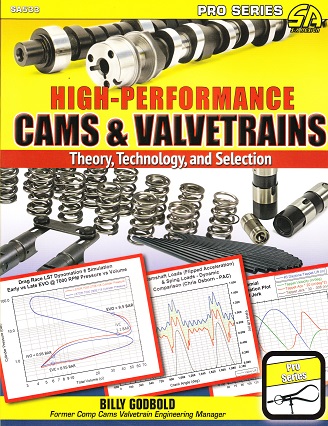HiPo Cams & Valvetrains: Theory, Technology & Selection
$24.95 WASItem# CARTECH-SA533
Weight: 1.5 lbs.
Publisher: CarTech Books
Softcover: 192 Pages w/ 457 Color Photos
Dimensions: 8.5 x 11.0 x 0.8 inches
FREE SHIPPING ON ORDERS $200+
High-Performance Cams & Valvetrains
Camshafts are the coach and conductor of any four-stroke engine from early flatheads to modern Formula 1. Performance engines are amazingly sensitive to how and when the valves to the combustion chamber open and close. The valvetrain configuration and flow characteristics may change significantly between applications, but the fundamental principles are universal. This allows the language, setup, dynamics, energy, and pressure aspects of a valvetrain to be covered in a way that is just as useful for optimizing a sub-15-hp go-kart engine as it is on a 500-plus-hp street engine or a modern 1,500-plus-hp NHRA Pro Stock engine.
In High-Performance Cams and Valvetrains: Theory, Technology, and Selection, farm-kid-turned-physicist Billy Godbold combines his quarter-century of experience with valvetrains at Comp Cams, Lunati, Crane Cams, and Edelbrock with the techniques he uses with professional teams in NASCAR, the NHRA, road racing, dirt-track racing, offshore racing, and land speed racing. He guides you to think about any valvetrain system with his perspective. Often lighthearted and filled with analogies, this book endeavors to make complex concepts easy to understand without watering down important details.
Specific configurations and applications are covered, providing techniques and examples for optimizing camshafts and the valvetrain around intakes, headers, superchargers, turbochargers, fuels, carburetors, and modern EFI applications. If you are planning or building a performance engine, or if you just want to know the science behind how cams and valvetrains work, this book is an indispensable resource.
TABLE OF CONTENTS:
- Chapter 1: The Language of Camshafts
- Chapter 2: Valvetrain Blueprinting
- Chapter 3: A Dynamic Understanding of Profiles: Velocity, Acceleration, and Jerk
- Chapter 4: Energy and Four-Stroke Engine Fundamentals
- Chapter 5: Under Pressure
- Chapter 6: Understanding Valve Events
- Chapter 7: Wave Tuning
- Chapter 8: Moving Valve Events
- Chapter 9: Camshaft and Cylinder Head Selection
- Chapter 10: Other Engine Considerations
- Chapter 11: Valvetrain Selection
- Chapter 12: Camshaft Selection Examples
- Glossary


 Cart
Cart


